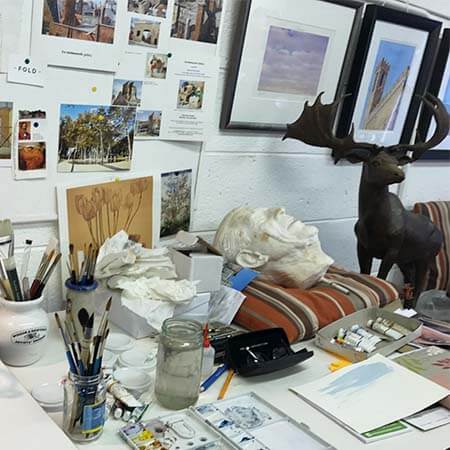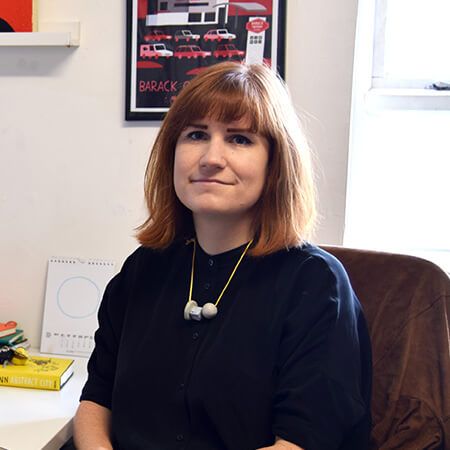Education at the National Gallery of Ireland
In a picture painted in 1916, Joanne Drum points out a dead body on O’Connell Bridge. In another picture, she spots a group of onlookers gathered high up on the parapet of a building. And, in another, she notes what’s written on the destination plate of a tram on College Green in 1901 – it says Terenure.
Joanne is the Education Officer at The National Gallery on Dublin’s Merrion Square and its her job to inspire, encourage and support learning through art.
“If you look at a picture with somebody standing beside you saying: ‘Have you noticed that tiny detail up in the corner?’, sometimes that can really bring it to life and make the whole experience more meaningful. More rich,” she says.

The Liffey Swim by Jack B. Yeats, 1923 – Photo © National Gallery of Ireland
Inspirational Dublin
This is the National Gallery of Ireland, but plenty of the artworks here have Dublin as their subject. One of the most prominent artists that took the city as their muse was Jack B. Yeats.
“Not only was he working in Dublin, but he was painting and drawing and sketching what he saw around him all the time, so he was kind of documenting the history of this city,” says Joanne.
A quality experience is much more important than just getting them through the door.
“And he was there at such an important time in history,” she adds. “This is a man who not only lived through two world wars, but also all the conflict and change that was happening in Ireland at the time as well.”
When art connects with significant moments in history, it often makes it easier to engage visitors and link in with school curriculums. It can spark interests beyond the realms of art as well.
Experiences that can change lives
One of the main goals of the National Gallery’s education department is to ensure visitors come away fired with interest and creative inspiration.
“That is what we see as a key reason to do what we do – to provide a way for the public to engage further with the collection,” explains Joanne. “You’ll meet people who say: ‘I came here as a child and I knew I wanted to be an artist or a doctor or whatever, because of one image I saw at the gallery’.”

The Nightingale by Harry Clarke, 1889-1931 – Photo © National Gallery of Ireland
George Bernard Shaw is probably the most famous example of this. He said that he owed the gallery “much of the only real education I ever got as a boy in Éire”.
He said that at the age of 87. By then, he was an ex-Dubliner, but he still remembered the National Gallery 80 years after his childhood experiences there.
That’s when he bequeathed a third of the royalties from his work to the gallery to fund acquisitions for the collection.
“So this is a long game,” says Joanne. “And you can’t quantify the experience as easily as you can quantify the numbers. However, we’re constantly trying to push the agenda that it’s not just about quantity. It’s about quality – giving people a quality experience is much more important than just getting them through the door.”
Making the National Gallery an inclusive space
Joanne and the rest of the education department here at the National Gallery aim to create a welcoming environment for everyone. That’s why they’re always busy working on activities and programmes for families, schools, third-level students, community groups and those with additional needs.
As part of an even longer game, they also encourage babies through the door.
If you see an animal, do the noise that the animal makes.
“What we want a baby to learn is that this place is for them,” explains Joanne. “When we sit down in our circle to do a baby workshop, parents ask what do we do here, what’s this about? And I joke and say the baby should come away knowing the difference between the Low and High Renaissance!”
However, she then makes her true intentions clear. She simply wants parents and children to know that they are welcome here.
Baby-friendly artworks
“I understand from my own experiences that coming in somewhere with a buggy, sometimes you can be made to feel very unwelcome,” says Joanne. “Luckily, there’s plenty of room for buggies… And if your baby’s caught short, well, we have nappies available. I mean it’s not IKEA, but…”
And how do the gallery’s youngest visitors react to the artworks decorating the vast wall space? It usually depends on what kind of art you show them.
Research shows that babies will react more to a face than to a landscape.
“I’ve done quite a lot of research into how babies and toddlers react to artwork. So when I do these workshops, I’ll often take the parents into the gallery and say: ‘Okay, so here’s a Picasso’. And I’ll tell them that the research shows that babies will react more to a face than to a landscape.”
Babies also tend to react more to bright, high contrast colours than dull, natural colours. So Joanne tells parents to show their babies different kinds of paintings – portraits and landscapes, bright and dull – and observe. Usually, she says, there’s a noticeable difference in their responses.
A tip for every art lover
“And if a parent is in here with a very small child, I would also do ‘say what you see’,” says Joanne. “In fact, that’s a good thing for anybody to do. If you’re standing in front of a painting, start saying in your mind what you’re seeing. You’re bound to notice more than you would if you were just looking.”
This is a key way of encouraging ‘visual literacy’ among visitors – to use the formal term. However, it’s relatively simple to do. It’s really just about looking in-depth. You can take this one step further by mimicking what you see.

A Camel Caravan by William Weekes, 1856-1909 – Photo © National Gallery of Ireland
“Try repeating a gesture that you see in an artwork,” says Joanne. “Or if you see an animal, do the noise that the animal makes. You have to be willing to make a bit of an eejit of yourself though!”
At this point, Dublin.ie wondered aloud about how to make the sound of camel.
We’re glad to say that if you find yourself spitting or hissing at a nativity scene in the National Gallery – preferably in the company of a two year old – well that’s just fine by Joanne Drum.
To discover self-guided tours, downloadable resources, programmes and upcoming workshops, visit The National Gallery’s website.
Article header image: Joanne Drum, Education Officer, National Gallery of Ireland – Photo © National Gallery of Ireland



